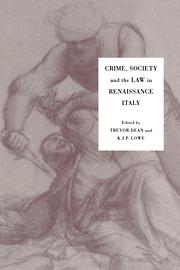Book contents
- Frontmatter
- Contents
- Illustrations
- List of contributors
- Preface
- 1 Writing the history of crime in the Italian Renaissance
- 2 Criminal justice in mid-fifteenth-century Bologna
- 3 The judicial system in Florence in the fourteenth and fifteenth centuries
- 4 The incidence of crime in Sicily in the mid fifteenth century: the evidence from composition records
- 5 Theology, nature and the law: sexual sin and sexual crime in Italy from the fourteenth to the seventeenth century
- 6 Practical problems in the enforcement of Italian sumptuary law, 1200–1500
- 7 The prince, the judges and the law: Cosimo I and sexual violence, 1558
- 8 Intervention by church and state in marriage disputes in sixteenth- and seventeenth-century Florence
- 9 The writer and the man. Real crimes and mitigating circumstances: il caso Cellini
- 10 The political crime of conspiracy in fifteenth- and sixteenth-century Rome
- 11 Fighting or flyting? Verbal duelling in mid-sixteenth-century Italy
- 12 Banditry and lawlessness on the Venetian Terraferma in the later Cinquecento
- 13 Mihi vindictam: aristocratic clans and rural communities in a feud in Friuli in the late fifteenth and early sixteenth centuries
- Index
12 - Banditry and lawlessness on the Venetian Terraferma in the later Cinquecento
Published online by Cambridge University Press: 14 October 2009
- Frontmatter
- Contents
- Illustrations
- List of contributors
- Preface
- 1 Writing the history of crime in the Italian Renaissance
- 2 Criminal justice in mid-fifteenth-century Bologna
- 3 The judicial system in Florence in the fourteenth and fifteenth centuries
- 4 The incidence of crime in Sicily in the mid fifteenth century: the evidence from composition records
- 5 Theology, nature and the law: sexual sin and sexual crime in Italy from the fourteenth to the seventeenth century
- 6 Practical problems in the enforcement of Italian sumptuary law, 1200–1500
- 7 The prince, the judges and the law: Cosimo I and sexual violence, 1558
- 8 Intervention by church and state in marriage disputes in sixteenth- and seventeenth-century Florence
- 9 The writer and the man. Real crimes and mitigating circumstances: il caso Cellini
- 10 The political crime of conspiracy in fifteenth- and sixteenth-century Rome
- 11 Fighting or flyting? Verbal duelling in mid-sixteenth-century Italy
- 12 Banditry and lawlessness on the Venetian Terraferma in the later Cinquecento
- 13 Mihi vindictam: aristocratic clans and rural communities in a feud in Friuli in the late fifteenth and early sixteenth centuries
- Index
Summary
In the later years of the sixteenth century the Venetian government fought a losing battle against the violence of gangs on the Terraferma. It was a time when the sound of a name such as Francesco Bertazuolo or Geronimo Tadino struck terror into the hearts of the population for miles around. The problem was no doubt endemic: the history of legal and judicial legislation, amply told by Gaetano Cozzi and Claudio Povolo, suggests its persistent presence before and after the years considered here. Moreover, nurtured as they are on I promessi sposi, all Italians will know this was not a problem uniquely associated with the republic. Yet this period produced on Venetian territory its own peculiar examples of villainy.
Even so, from time to time there were optimistic reports of peaceful intermissions, often associated with the imposition of a ban against the carrying of arms. For example, the Venetian rector at Udine in the summer of 1569 asked for an extension of such a ban, which over the previous months had got rid of violent quarrelling and murder under his jurisdiction. He noticed the additional, apparently consequential, advantage of an absence of the foreign bravoes who had previously supported the noble factions. In Brescia a law against bearing wheel-lock arquebuses was imposed by Giacomo Soranzo in 1574.
- Type
- Chapter
- Information
- Crime, Society and the Law in Renaissance Italy , pp. 221 - 248Publisher: Cambridge University PressPrint publication year: 1994
- 1
- Cited by



